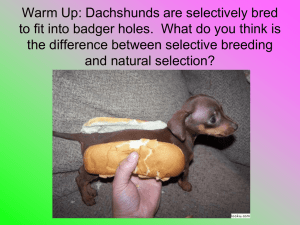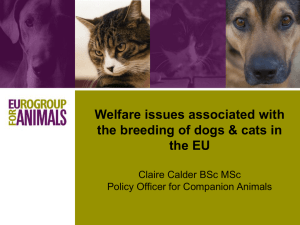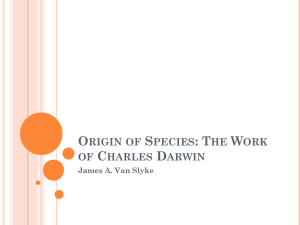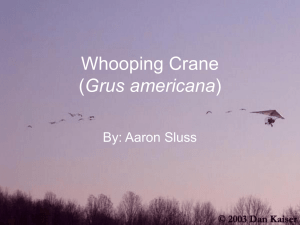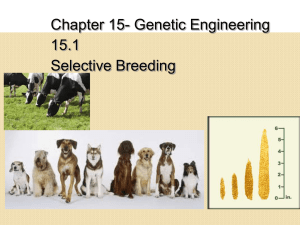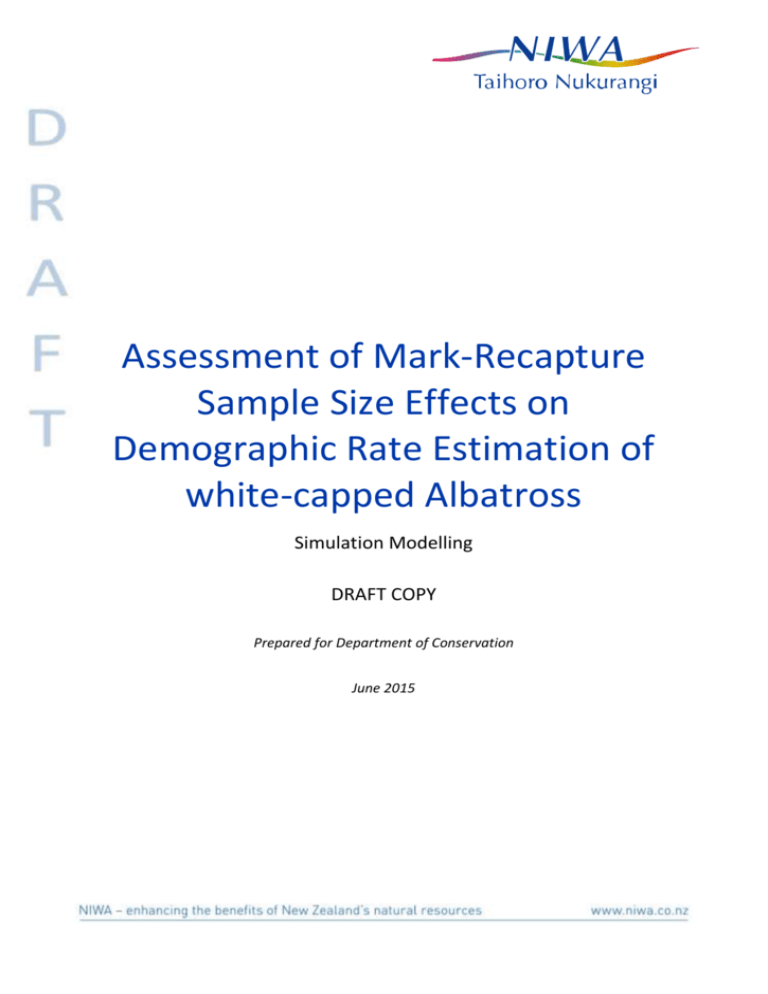
Assessment of Mark-Recapture
Sample Size Effects on
Demographic Rate Estimation of
white-capped Albatross
Simulation Modelling
DRAFT COPY
Prepared for Department of Conservation
June 2015
Prepared by:
Jim Roberts
Ian Doonan
David Thompson
For any information regarding this report please contact:
Jim Roberts
Fisheries Modelling
+64-4-386 0867
jim.roberts@niwa.co.nz
National Institute of Water & Atmospheric Research Ltd
Private Bag 14901
Kilbirnie
Wellington 6241
Phone +64 4 386 0300
NIWA CLIENT REPORT No:
Report date:
NIWA Project:
XXXX
June 2015
DOC15306
© All rights reserved. This publication may not be reproduced or copied in any form without the permission of
the copyright owner(s). Such permission is only to be given in accordance with the terms of the client’s
contract with NIWA. This copyright extends to all forms of copying and any storage of material in any kind of
information retrieval system.
Whilst NIWA has used all reasonable endeavours to ensure that the information contained in this document is
accurate, NIWA does not give any express or implied warranty as to the completeness of the information
contained herein, or that it will be suitable for any purpose(s) other than those specifically contemplated
during the Project or agreed by NIWA and the Client.
Contents
Executive summary .......................................................................................................................4
1
Introduction ........................................................................................................................5
2
Methods ..............................................................................................................................5
2.1
Modelling approach .............................................................................................................5
2.2
Input Values .........................................................................................................................6
3
Results ................................................................................................................................8
4
Discussion ......................................................................................................................... 11
5
Acknowledgements ........................................................................................................... 11
6
References......................................................................................................................... 11
Figures
Figure 3-1:
Figure 3-2:
Figure 3-3:
Parameter estimates (left) and associated c.v. (right) with different scenarios
of numbers of banded individuals in the initial study year (top = 150
individuals; middle = 300; bottom = 600) and number of years with resighting
effort (each bar represents a different value).
The c.v. associated with adult survival estimates with different scenarios of
numbers of banded individuals in the initial study year (150, 300 or 600
individuals) and subsequent number of years with resighting effort (2-10
years).
Parameter estimates (left) and associated c.v. (right) with different scenarios
of resighting probability for breeders and non-breeders.
9
10
10
Reviewed by and Approved for release by
XXXX
Assessment of mark-recapture sample size effects on demographic rate estimation of white-capped albatross
Executive summary
Disappointment Island, within the Auckland Islands group, supports over 70,000
breeding pairs of white-capped albatrosses Thalassarche cauta steadi annually, the
largest colony of New Zealand’s most abundant albatross species. This species
interacts with commercial fisheries and ranks highly within the Level 2 Seabird Risk
Assessment process, but with a relatively high level of uncertainty around the estimate
of adult survival.
A study was undertaken to assess the effect of alternative mark-recapture sampling
approaches to a potential mark-resighting study of white-capped albatross on the
estimation of demographic rates.
A data simulator was used to create dummy mark-resighting observations for a single
banding year with alternative scenarios of: banded sample size (150, 300 or 600
breeding individuals); number of subsequent consecutive resighting years (2, 3, 4, 5 or
10 years); and resighting probability of breeders (0.6 or 0.4) and non-breeders (0.0 or
0.1).
The SeaBird demographic modelling software was then used to determine variability in
the estimates of survival and breeding rate using the dummy mark-resighting
observations. This assessment assumed that demographic rates were constant with
respect to year and age and variability of demographic rates of wild populations are
likely to be greater than those obtained by this assessment.
Increasing the banded sample size from 150 to 600 individuals led to an increase in the
precision (c.v.) of annual survival breeding rate estimates.
With an input survival rate of 0.95 and a banded population of 150 individuals, the
range of survival estimates was wide with 5 years of resighting effort (range from 0.910.99, x̅ = 0.95), though was much narrower with 10 years of resighting effort (0.930.96, x̅ = 0.95). With a banded sample size of 600 individuals, the range of survival
estimates was narrow with 5 years of resighting effort (0.93-0.97, x̅ = 0.95).
The precision of demographic rate estimates was not greatly affected by reducing the
resighting probability of breeders from 0.6 to 0.4, though reducing the resighting
probability of non-breeders from 0.10 to 0.00 produced imprecise estimates that were
for some samples very different from input values.
To produce estimates of demographic rates that would be suitably precise for risk
assessment purposes, this data simulation approach indicates that resighting effort
over 5-10 years would be required subsequent to banding of a population between
150-600 individuals. In a wild population, demographic rates are likely to change
through time, so that greater sampling effort (in terms of banded individuals, number
of resighting years or even resighting effort) may be required.
4 Assessment of mark-recapture sample size effects on demographic rate estimation of white-capped albatross
1
Introduction
White-capped albatross Thalassarche cauta steadi is endemic to New Zealand and breeds almost
exclusively at the Auckland Islands, where Disappointment Island holds the majority (ca. 95%, Baker
et al. 2014) of the breeding population. This taxon is currently classified as ‘At Risk – Declining’
(Robertson et al. 2013), although Baker et al. (2014) concluded that there was no clear evidence for a
systematic monotonic decline in the breeding population over the eight years (2006 to 2013) of their
aerial survey study. Nevertheless, white-capped albatross ranks very highly within the Level 2 Seabird
Risk Assessment process (Richard & Abraham 2013), with a relatively high level of uncertainty around
the estimate of adult survival.
This project seeks to establish whether a study population of white-capped albatross could be
developed at Disappointment Island that will enable key life-history parameters to be robustly
estimated, with a particular, but not exclusive, focus on adult survival. While white-capped albatross
breeds at other sites within the Auckland Islands, only the large population at Disappointment Island
is readily and easily accessible, is free of introduced mammalian pests (feral pigs Sus scrofa are
present on main Auckland Island and regularly destroy accessible nests and nest contents) and
represents the only practicable and viable location for such a study population. Previously, a study
population was established at South West Cape, on main Auckland Island, at a site that was
accessible to field workers with the aid of a rope ladder, but which was inaccessible to pigs. However,
the study site was relatively small and supported a correspondingly modest number of breeding
birds: a total of 122 banded birds were available for mark-recapture analyses over four years of
resighting effort (Francis 2012). Demographic parameters were estimated from this small study
population, but confidence intervals were relatively large. For example, adult survival was estimated
at 0.96, with 95% confidence intervals of 0.91-1.00, and the annual probability of breeding was
estimated at 0.68, with 95% confidence intervals of 0.58-0.81 (Francis 2012).
For this study, we conducted demographic assessments using simulated mark-resighting data to
assess the precision of demographic rate estimates that might be expected given a particular markresighting methodology (i.e. number of banded individuals and subsequent resighting years).
2
Methods
2.1
Modelling approach
A two-phase modelling analysis was adopted for this assessment:
1.
A data simulator was used to create dummy mark-resighting observations for a given
number of individuals in a single banding year (150, 300 or 600 individuals) and
alternative scenarios of number of subsequent years with resighting effort (2-10
years), given a user-specified set of input values of annual survival, breeding and
resighting probabilities.
2.
Outputs from the data simulator were then used by a demographic assessment model
(SeaBird) to generate estimates of annual survival, breeding and resighting
probabilities.
Twenty simulated data sets were generated for each configuration of parameter values and sample
sizes and the 95% CI calculated.
Assessment of mark-recapture sample size effects on demographic rate estimation of white-capped albatross 5
The data simulator produced observations in a format that could be used by SeaBird. The data
simulator was developed in R and observations were produced in two steps: 1) a Leslie matrix model
was used to generate annual mark-resighting observations for each individual banded in the initial
year, given a set of demographic rates, assuming that all individuals that were still alive in a given
year were observed; 2) a proportion of the resighting observations were then marked as not seen in
a year in accordance with the resighting probability. The statistical distribution used was the
binominal for both resighting and survival.
The SeaBird model partition was comprised of two classes: breeders and non-breeders (each a plus
group i.e., demographic rates were constant with respect to age). Transition probabilities between
states were given by the annual probability of breeding for individuals that bred or did not breed in
the previous year and of survival. In addition state-dependent resighting probability was estimated
separately for breeders and non-breeders in the current year. Thus, five parameters were estimated
(respective values used by the data simulator in parentheses):
2.2
Surv (0.95) – the annual probability of survival;
Prbb (0.2) – probability of breeders in year-1 breeding in the current year;
Prnb (0.8) – probability of non-breeders in year-1 breeding in the current year;
Resb (0.6, 0.4 used in a sensitivity run) – the annual resighting probability of breeders;
Resn (0.1, 0.0 used in a sensitivity run) – the annual resighting probability of nonbreeders.
Input Values
Number of breeding birds banded
The reference number (150) reflects the number of breeding birds banded in 2015 (Thompson et al.
2015). Simulations where this number is doubled, and then doubled again reflect reasonable and
achievable banded totals of breeding birds at Disappointment Island.
Years of resighting effort
Simulations were run for two, three, four, five and ten years of resighting effort, with the reference
set at five years. Five years was selected as being both realistic and achievable given the number of
annual visits to the Auckland Islands (at least 20 consecutive years and ongoing) for a range of
research activities, onto which white-capped albatross resighting work could be added, with ten
years as a possible target should the current interest in Auckland Island research be maintained.
Annual survival (surv)
We use a reference value of 0.95 for adult annual survival. This is realistic given earlier estimates for
white-capped albatross (0.96, Francis 2012), and very similar estimates for other species of albatross
(for example, Waugh et al. 1999, Converse et al. 2009, Francis & Sagar 2012).
Annual breeding rate (Prbb and Prnb)
This is the probability of a bird breeding in year-1 then breeding in year0 (Prbb), and similarly the
probability of a non-breeding bird in year-1 breeding in year0 (Prnb). In annual species, the
proportion of breeding birds in one year that choose to breed in the following year, regardless of
6 Assessment of mark-recapture sample size effects on demographic rate estimation of white-capped albatross
whether that breeding attempt was successful or not, is generally very high. For example, in blackbrowed albatrosses Thalassarche melanophris in the Falkland Islands only approximately 6% of
breeding birds chose not to breed the following year (Catry et al. 2011). For biennial species,
successful breeders in one year tend not to breed the following year, whereas failed breeders (which
fail relatively early in the breeding season) and breeders that are not breeding in a particular year
usually breed the following year. For example, an estimated 6% of breeding grey-headed albatrosses
T. chrysostoma in year-1 also bred in year0, whereas 84% of non-breeding birds in year-1 chose to
breed in year0 (Converse et al. 2009). Francis (2012) concluded that white-capped albatross was
intermediate between biennial and annual breeding species. Here we have adopted annual breeding
rate reference values of 0.2 and 0.8 for birds that were breeders and non-breeders in year-1,
respectively. These values are towards the biennial end of the breeding strategy spectrum for
albatrosses and as such are conservative in the sense that if white-capped albatross are in fact more
annual-like than we have assumed, then the resighting of individuals will be greater than we have
estimated.
Annual resighting probability for breeding birds (Resb)
This parameter reflects the likelihood of being able to detect a banded bird should that bird be
breeding in a given year, and incorporates realistic logistic constraints of being able to spend time
(effort) at Disappointment Island. Currently, only one member of 150 pairs of breeding white-capped
albatrosses has been banded (hence overall banded total of 150 individuals). Therefore, there would
be, on average, a 50% chance of the banded bird from a pair being present on the nest during the
incubation or guard stages of the breeding season (when any resight work would be undertaken). As
banded partners of land-based birds return to the colony, to take over incubation or guarding duties,
the proportion of the marked population resighted will increase. The rate at which birds change-over
at active nests will reflect in part the duration of foraging trips, which for white-capped albatrosses
during the guard stage are approximately two days (Torres et al. 2011), but longer (in some cases
over two weeks) during the incubation phase (Thompson et al. unpublished data). Resighting
probability data for nesting albatrosses are scarce, but for Buller’s albatross Thalassarche bulleri at
the Snares, 75-80% of banded breeding birds are resighted over a period of up to one week of effort
(P. Sagar pers.com). Here we have adopted a value of 0.6, less than would be expected for Buller’s
albatross, reflecting the less-frequent change-overs in white-capped albatross, and additionally the
greater logistic constraints in working at Disappointment Island compared to the Snares.
Annual resighting probability for non-breeding birds (Resn)
Analogous to the resighting probability for breeding birds above, this parameter reflects the
likelihood of being able to detect a banded bird should that bird be non-breeding in a given year, and
again incorporates realistic logistic constraints of being able to spend time (effort) at Disappointment
Island. Non-breeding albatrosses (i.e. birds that have bred previously, but which skip breeding in
some years) are not constrained to return to the breeding colony and typically, but especially in
biennially-breeding species, may not be present at the breeding colony during the breeding season
(Mackley et al. 2010). The majority (approximately 80%) of white-capped albatrosses remain in
Australasia year-round, and even those that migrate to waters off South Africa during the nonbreeding period return to New Zealand over the summer (Thompson et al. unpublished data). Nonbreeding white-capped albatrosses have been observed at South West Cape occupying nest sites
used in previous years. Here we adopt a reference value of 0.1 to reflect the relatively low probability
of sighting non-breeding birds at the breeding colony, even when wearing a relatively large and
uniquely-numbered plastic leg band.
Assessment of mark-recapture sample size effects on demographic rate estimation of white-capped albatross 7
All individuals were assigned as breeders in the initial banding year. Demographic rates were
assumed to be constant with respect to resighting year and the time period over which rates were
estimated varied with the number of years of resighting effort. The mean, range and c.v. of
parameter estimates were reported for 20 samples of dummy mark-recapture observations
generated by the data simulator.
3
Results
The close proximity of the mean parameter estimates obtained from the demographic assessment to
values used to generate the dummy observations suggests that there were no major biases in the
estimation of parameters that might relate to model structures of the data simulator or the
demographic assessment model (Figure 3-1).
Increasing the banding sample size (from 150 to 600 individuals) or the number of consecutive
resighting years subsequent to banding led to an increase in the precision of all estimated
parameters (Figure 3-1, right-hand plot). Focussing on annual survival estimates, with a banded
population of 150 individuals the range of estimates obtained (across 20 samples of mark-resighting
observations) was quite large even with 5 years of resighting effort (range from 0.91-0.99, x̅ = 0.95),
though this was greatly reduced with 10 years of resighting effort (0.93-0.96, x̅ = 0.95). With a
banded sample size of 600 individuals, the range of estimates was quite small with just 5 years of
resighting effort (0.93-0.97, x̅ = 0.95). The rate of decrease in the c.v. of survival estimates was
greatest in first 2-4 years of consecutive resighting effort after banding (for 150 to 600 banded
individuals), with relatively smaller decreases in c.v. with additional years of effort (Figure 3-2).
The precision of breeding rate estimates was lower than that of survival for a given number of
banded individuals or number of resighting years (Figure 3-1). A large increase in the precision of
breeding rate (and survival) estimates was obtained when increasing the number of resighting years
from 2 to 3 years. However, beyond 3-years of resighting effort, the precision of breeding rate
estimates appears to be more sensitive to increasing banded sample size than to additional
resighting years relative to survival estimates (from a visual inspection of Figure 3-1).
The precision of survival estimates was reduced slightly by reducing the resighting probability of
breeders from 0.6 to 0.4 (from 2.3 to 3.9 for a banded sample of 150 individuals). Reducing the
resighting probability of non-breeders from 0.10 to 0.00 produced precise estimates of survival (c.v. =
1.9), though led to a strong positive bias in survival estimates (13 out of 20 samples were at the
upper bound of 1.00) and also led to breeding rate estimates that were very different from the input
values (Figure 3-3).
8 Assessment of mark-recapture sample size effects on demographic rate estimation of white-capped albatross
Figure 3-1: Parameter estimates (left) and associated c.v. (right) with different scenarios of numbers of
banded individuals in the initial study year (top = 150 individuals; middle = 300; bottom = 600) and number
of years with resighting effort (each bar represents a different value). Bars and error bars on left-hand plot
represent the mean and range of estimates. Parameter names annotated as “Surv” – annual probability of
survival, “Prbb” – probability of breeders in year-1 breeding in the current year, “Prnb” – probability of nonbreeders in year-1 breeding in the current year, “Resb” – the annual resighting probability of breeders, “Resn”
– the annual resighting probability of non-breeders.
Assessment of mark-recapture sample size effects on demographic rate estimation of white-capped albatross 9
Figure 3-2: The c.v. associated with adult survival estimates with different scenarios of numbers of banded
individuals in the initial study year (150, 300 or 600 individuals) and subsequent number of years with
resighting effort (2-10 years).
Figure 3-3: Parameter estimates (left) and associated c.v. (right) with different scenarios of resighting
probability for breeders and non-breeders. Banded sample size = 150; 5 years of resighting effort; bars and
error bars on left-hand plot represent the mean and range of estimates. Parameter names annotated as “Surv”
– annual probability of survival, “Prbb” – probability of breeders in year-1 breeding in the current year, “Prnb”
– probability of non-breeders in year-1 breeding in the current year, “Resb” – the annual resighting probability
of breeders, “Resn” – the annual resighting probability of non-breeders; legend of right-hand plot annotated as
“100b/100n” – 100% annual resighting probability of breeders and non-breeders, “60b/10n” – 60% resighting
probability of breeders and 10% of non-breeders (reference run), “40b/10n” – 40% resighting probability of
breeders and 10% of non-breeders, “60b/0n” – 60% resighting probability of breeders and 0% non-breeders.
10Assessment of mark-recapture sample size effects on demographic rate estimation of white-capped albatross
4
Discussion
There are a number of limitations to this study, e.g. we assumed that demographic rates were
constant with respect to year, whereas they would likely be year-varying in a wild population. As
such, the estimates of precision reported here are likely to be low relative to what would actually be
observed. In addition, only a single banding year was used, though multiple banding years are
typically attempted for a study population. Note that the data simulator can be configured to
produce multiple years of banding effort with associated resighting observations.
To produce estimates of demographic rates that would be suitably precise for risk assessment
purposes, the approach adopted here indicates that resighting effort over 5-10 years would be
required subsequent to banding of a population between 150-600 individuals. In a wild population,
demographic rates are likely to change through time, such that greater sampling effort (in terms of
banded individuals, number of resighting years or even resighting effort) may be required. Much
longer time series of resighting effort may be required to obtain similarly precise estimates of
breeding rate.
The very poor estimation of demographic rates when adopting a zero resighting probability of nonbreeders suggests that a suitable amount of effort should be expended on resighting non-breeding
individuals that have been banded as part of the mark-resighting study.
The modelling approach used in this study is sufficiently flexible to allow analogous mark-recapture
sampling method assessments for any species for which a mark-recapture study may be desirable,
i.e., need not be limited to seabird species). This study considered the effects of banded sample size
and years of resighting effort on the precision of demographic parameter estimation. Further studies
could simultaneously consider the effects of varying resighting probability, of multiple banding years
and of species with different reproductive strategies (e.g. annual v biennial breeders, through
alteration of relative breeding rates of those that did or did not breed in the previous year). Also, the
simulator could use distributions other than the binomial distribution, that have more errors and
perhaps some process error between years to explore a wider range of variability. These assessments
can be tailored to the reproductive biology and sampling constraints specific to a particular study
population.
5
Acknowledgements
We would like to thank the Conservation Services Programme (CSP) of the Department of
Conservation and the CSP technical working group for funding and reviewing this study.
6
References
Baker, G.B.; Jensz, K.; Cunningham R. (2104). White-capped albatross aerial survey 2014:
Final Report. Prepared for Conservation Services Programme, Department of
Conservation, Wellington.
Catry, P.; Forcada, J.; Almeida, A. (2011). Demographic parameters of black-browed
albatrosses Thalassarche melanophris from the Falkland Islands. Polar Biology 34: 12211229.
Assessment of mark-recapture sample size effects on demographic rate estimation of white-capped albatross 11
Converse, S.J.; Kendall, W.L.; Doherty, P.F.; Ryan, P.G. (2009). Multistate models for
estimation of survival and reproduction in the grey-headed albatross (Thalassarche
chrysostoma). Auk 126: 77-88.
Francis, R.I.C.C. (2012). Fisheries risks to the population viability of white-capped albatross
Thalassarche steadi. New Zealand Aquatic Environment and Biodiversity Report No. 104.
Ministry for Primary Industries, Wellington. 24p.
Francis, R.I.C.; Sagar, P.M. (2012). Modelling the effect of fishing on southern Buller’s
albatross using a 60-year dataset. New Zealand Journal of Zoology 39: 3-17.
Mackley, E.K.; Phillips, R.A.; Silk, J.R.D.; Wakefield, E.D.; Afanasyev, V.; Fox, J.W.; Furness,
R.W. (2010). Free as a bird? Activity patterns of albatrosses during the nonbreeding
period. Marine Ecology Progress Series 406: 291-303.
Richard, Y.; Abraham, E.R. (2013). Risk of commercial fisheries to New Zealand seabird
populations. New Zealand Aquatic Environment and Biodiversity Report No. 109.
Ministry for Primary Industries, Wellington. 58p.
Robertson, H.A., Dowding, J.E., Elliott, G.P., Hitchmough, R.A., Miskelly, C.M., O’Donnell,
C.F.J., Powlesland, R.G., Sagar, P.M., Scofield, R.P., Taylor, G.T. (2013). Conservation
status of New Zealand birds, 2012. New Zealand Threat Classification Series 4,
Department of Conservation, Wellington, 22p.
Thompson, D.; Parker, G.; Rexer-Huber, K.; Sagar, P. (2015). Feasibility of monitoring whitecapped albatross at Disappointment Island. Unpublished report to the Conservation
Services Programme, Department of Conservation, Wellington. 8p.
Torres, L.G.; Thompson, D.R.; Bearhop, S.; Votier, S.; Taylor, G.T.; Sagar, P.M.; Robertson,
B.C. (2011). White-capped albatrosses alter fine-scale foraging behaviour patterns when
associated with fishing vessels. Marine Ecology Progress Series 428: 289-301.
Waugh, S.M.; Weimerskirch, H.; Moore, P.J.; Sagar, P.M. (1999). Population dynamics of
black-browed and grey-headed albatrosses Diomedea melanophrys and D. chrysostoma
at Campbell Island, New Zealand, 1942-96. Ibis 141: 216-225.
12Assessment of mark-recapture sample size effects on demographic rate estimation of white-capped albatross



